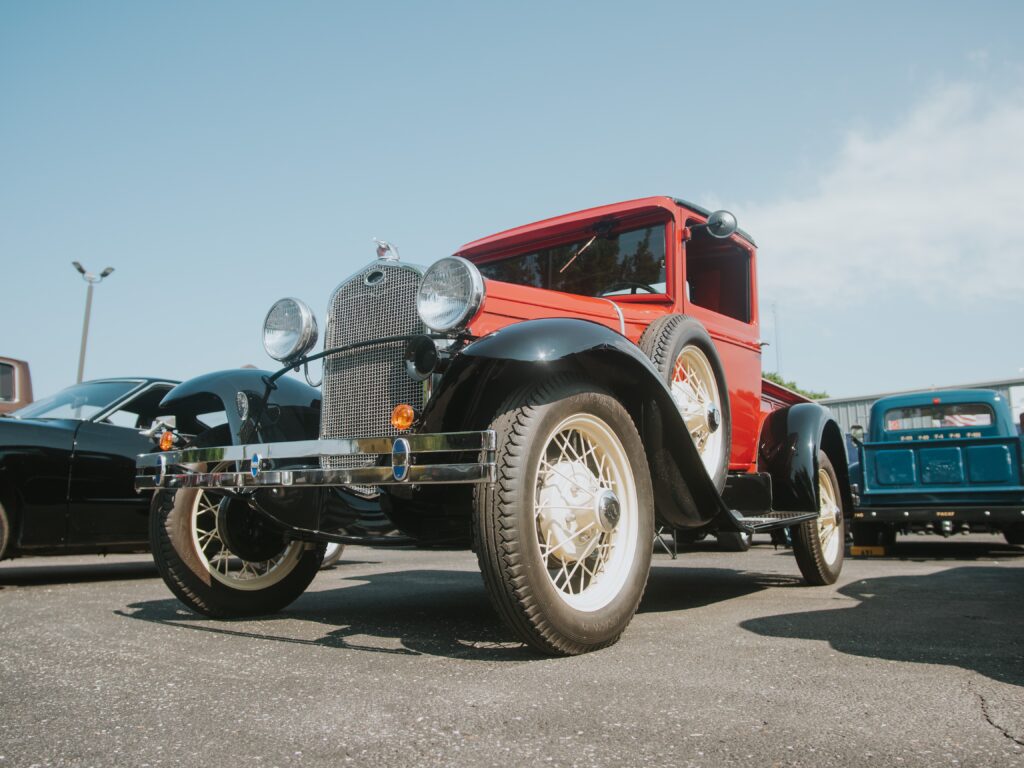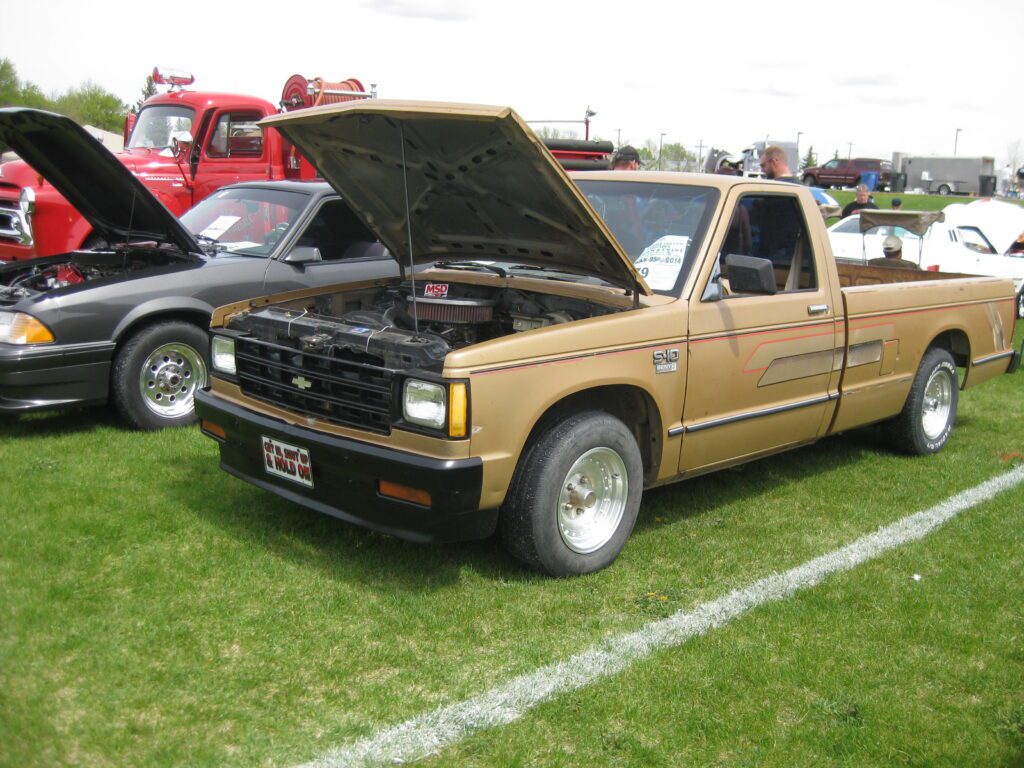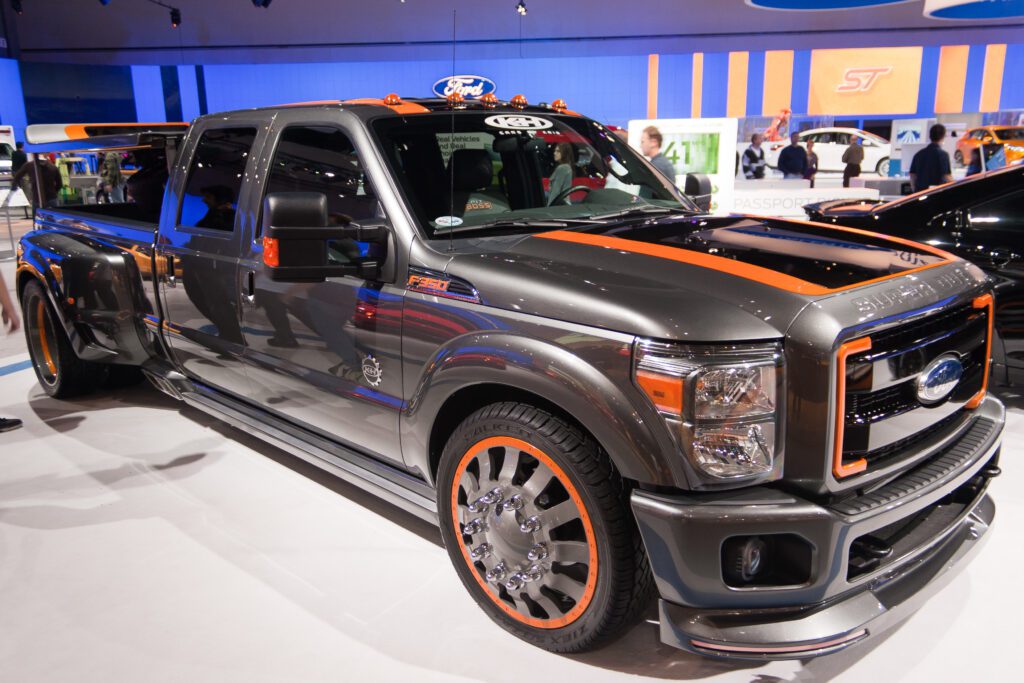Pickup Trucks: From Function to Fashion – A Century of Evolution
From the picturesque backdrop of amber waves of grain to the roaring engines on freeways, the pickup truck has made an indelible mark on the American landscape. Its journey, from a rudimentary utility vehicle to a symbol of luxury and status, mirrors the ethos of relentless innovation and adaptability that characterizes American automotive history.

The concept of a pickup truck — a vehicle with a cab and an open rear cargo area — has origins that predate the formal introduction of vehicles labeled as “pickup trucks” by major manufacturers. In the early days of the automobile, many vehicles were modified by owners or local craftsmen to fit a specific need, which included adding cargo beds to cars.
However, when talking about factory-produced pickup trucks, credit often goes to the Ford Model T Runabout with Pickup Body, which was introduced in 1925. This vehicle came with a cargo bed, making it one of the earliest factory-produced pickups. The Model T chassis had been used prior to this by aftermarket companies to create truck-like vehicles, but the 1925 Runabout was a significant step towards standardizing the pickup truck design.

Around the same time, Chevrolet also introduced its own version of a factory-built pickup. As the 1920s progressed, other manufacturers began to see the potential of this vehicle type and started producing their own versions.
The pickup truck symbolizes the sheer utility of the automobile. It reminds us of all the things a purpose-built vehicle can help us get done—moving cargo, hauling gear, and getting to the back forty—and of all the memories we can make with them—hopping in the bed to watch a drive-in movie or laying out under the stars, or filling it up with tarps and water for a country-style hot tub. The truck is an icon in automotive lore, and this is how it became one.
The Genesis: 1920s-1930s
To understand the essence of the pickup truck, one must journey back to the early 20th century. The urban landscapes were transforming with the automobile revolution, but it was the heartland of America, its vast farms, that would birth the pickup truck. Initially conceived as a utility vehicle, the early models were essentially cars modified with a truck bed to transport goods.

In the 1920s and 1930s, pickup trucks began to emerge as distinct vehicles tailored for work and utility, transitioning away from their early roots where they were often just modified cars with a cargo bed.
Initially, in the 1920s, many pickups were still closely related to their passenger car counterparts in design, often showcasing a car-like front end with a simple cargo area attached to the rear. The emphasis during this era was more on practicality than comfort, so interiors were basic and amenities sparse.

As the 1930s rolled in, the demand for more specialized work vehicles prompted manufacturers to introduce more robust and purpose-built designs. Trucks became sturdier, with beefier frames, more durable suspensions, and engines that were designed for torque and hauling rather than just speed. This was also the period when the styling of trucks started to receive more attention, with manufacturers incorporating design elements to make them more visually appealing.
Their evolution during this time was shaped by a mix of economic necessity, technological advancements, and a growing recognition of the truck’s importance in the American landscape, both in urban settings and in the rapidly expanding agrarian sectors. By the end of the 1930s, pickup trucks had cemented their position not just as utility vehicles, but as symbols of hard work and resilience, traits that continue to define them today.
The Great Depression of the 1930s had a significant impact on the automotive industry. However, the need for reliable work vehicles meant that pickup trucks maintained a steady presence in the market.

Ford’s Model T Runabout, introduced in 1925, stands out in this era. Often credited as one of the pioneers in the pickup segment, it sported heavy-duty rear springs and an optional cargo box. It was the workhorse of the American farmer, rugged and reliable, ready to traverse the uneven terrains of rural landscapes. This vehicle, sold with the name “pickup body,” is also the first to use the word pickup to describe a truck, although it’s likely that early auto enthusiasts who custom-built their own trucks out of standard Model Ts and other cars were already referring to them as pickups before Henry Ford cashed in on the term.
The War Years: Mobilizing Forces and Accelerating Innovation
During the World War II era, American pickup truck design was profoundly influenced by the war effort and the associated demands on the automotive industry. With the onset of the war, civilian vehicle production was largely halted as manufacturers pivoted to support wartime production, creating military vehicles, equipment, and other essentials for the war.

One significant impact of this shift was the focus on durability and simplicity in design. Pickup trucks and other vehicles had to be rugged, easily repairable, and able to withstand a range of challenging environments, from the deserts of North Africa to the jungles of the Pacific. This emphasis on durability and simplicity led to advancements in chassis construction and the overall robustness of vehicles.
Material rationing and shortages also played a role. With metals like chrome and stainless steel being reserved for the war effort, truck designs became more austere, lacking the decorative elements seen in the pre-war years. This resulted in a stripped-down, functional aesthetic that prioritized utility over luxury.
The technological advancements made during the war, including improvements in engine technology and drivetrains, influenced post-war truck designs. After the war, as manufacturers returned to civilian vehicle production, there was a surge in demand. The lessons learned and innovations developed during the war years were integrated into new models, which became more powerful, reliable, and efficient.
Moreover, the experiences of the war influenced societal perceptions of vehicles. Pickup trucks, having played a crucial role in various theaters of the war, emerged with a reinforced image of reliability and ruggedness, an image that manufacturers would continue to emphasize in the post-war years.
The Suburban Surge: 1950s-1970s
Post-war America was a land of prosperity, marked by economic growth and the rise of suburban neighborhoods. As families moved to white-picket fenced homes, the pickup truck found a new role. No longer confined to farms or battlegrounds, trucks became companions for family vacations, camping trips, and beach outings.

However, the 1970s brought challenges. The oil crisis shook the automotive world, prompting manufacturers to rethink designs. While trucks like Ford’s F-Series maintained their stronghold, the market saw the emergence of compact trucks, such as the Datsun Compact Pickup, offering fuel efficiency as their USP.
In the 1950s through the 1970s, the American pickup truck underwent significant evolution, both in terms of design and functionality. The post-war boom of the 1950s brought prosperity and a burgeoning suburban landscape, which shifted the role of the pickup from a purely work-oriented vehicle to one that also catered to personal and recreational uses. This shift was mirrored in the designs, which began to incorporate more comfortable interiors, better ride quality, and stylistic elements that echoed the optimism and flair of the era.

As we entered the 1960s, pickups began to offer more variations in terms of size, powertrains, and trim levels. The decade saw the introduction of trucks with four-door crew cabs, extended cabs, and a broader range of engine options, reflecting a market that was becoming increasingly diverse in its needs. The influence of the burgeoning car culture of the ’60s, with its muscle cars and emphasis on performance, was felt in the pickup segment too. Trucks began to offer more powerful engine options, and the styling became more aggressive and distinct.

The 1970s brought challenges in the form of the oil crisis, which prompted a rethinking of vehicle size and efficiency. While the early part of the decade saw the continuation of the trend towards larger and more powerful trucks, the latter half saw manufacturers grappling with the need for fuel efficiency. There was an increased emphasis on aerodynamics, lighter materials, and more fuel-efficient engines. However, the core essence of the pickup as a versatile, rugged vehicle remained intact. The 1970s also saw the rise of the luxury pickup, with manufacturers introducing high-end trim levels that offered a range of amenities previously reserved for passenger cars.

The Blurring Lines: 1980s-2000s
The late 20th century saw a paradigm shift in consumer expectations. Pickup trucks, once the epitome of ruggedness, began sporting luxurious features. The 1980s and 1990s models, like Dodge Ram 1500 or Ford F-150, bore little resemblance to their austere ancestors. Interiors were revamped with plush seating, power windows, sophisticated infotainment systems, and more.
The 2000s continued this trend with unabashed fervor. Vehicles like the Cadillac Escalade EXT weren’t just trucks; they were status symbols. They catered to an audience that wanted the power of a truck but the comfort of a luxury sedan.
During the 1980s and 1990s, the American pickup truck market underwent a period of significant transformation, mirroring broader trends in the automotive industry and shifts in consumer preferences.
In the 1980s, the lingering effects of the oil crisis from the previous decade still held sway, leading to a heightened emphasis on fuel efficiency. Manufacturers began to explore innovative solutions to improve gas mileage without sacrificing the power and capability that pickup buyers demanded. The introduction of more efficient engines, improved aerodynamics, and the occasional use of lighter materials played a part in achieving better fuel economy.
The late 1980s and the 1990s also saw a growing interest in trucks as personal and family vehicles, not just workhorses. This was evident in the increased availability of extended cab and crew cab configurations, allowing for more passengers and emphasizing comfort and convenience features. Interiors started resembling those of passenger cars, with better cushioning, advanced entertainment systems, and air conditioning becoming more common.





Safety became a notable concern during this period. Manufacturers started including features like anti-lock brakes and, eventually, airbags. As environmental concerns began to take center stage, there were also moves towards making trucks more environmentally friendly, with some manufacturers exploring alternative fuels and cleaner engine technologies.
Furthermore, branding and niche marketing strategies became more pronounced. Trucks were no longer generic tools but carried distinct personalities, targeting different demographics and lifestyles. For instance, the rise of off-road and sporty variants catered to recreational users and those seeking a more adventurous image.

The import market also began to make inroads in the 1990s. Brands like Toyota and Nissan offered American consumers different options and styles, bringing in a touch of global competition and forcing domestic automakers to further innovate.
In essence, the 1980s and 1990s marked a period of maturation for the American pickup truck market. The trucks of this era were not just about raw capability but encapsulated a blend of comfort, efficiency, safety, and style, reflecting the diverse needs and desires of an evolving consumer base.
The Evolution of the Pickup: From Utility to Ubiquity
In the grand tapestry of American automotive history, the pickup truck has woven its unique narrative, transitioning from a purely utilitarian vehicle to an emblem of lifestyle and identity. This journey traces not just the evolution of a vehicle type but the shifting aspirations and values of the American populace.
The inception of the pickup truck was deeply rooted in function. In the early 20th century, as America’s agrarian landscape expanded and urban centers burgeoned, there was a palpable need for vehicles that could transport goods efficiently. The pickup, with its modest cab and open bed, emerged as the answer, serving farmers, tradesmen, and businesses alike. Its design was straightforward, dictated by purpose rather than aesthetics.



However, as the decades rolled on, America underwent significant sociocultural shifts. The post-war era of the mid-20th century heralded prosperity, suburban sprawl, and a burgeoning middle class. The pickup truck, while still indispensable in its traditional roles, began to be seen through a different lens. The vast open highways and the spirit of the frontier, long romanticized in American lore, found a modern-day chariot in the pickup. It wasn’t just about hauling goods anymore; it was about carving out space in the vast American landscape, with all the freedom and autonomy it promised.
Marketing campaigns of the era tapped into this sentiment. They painted the pickup not just as a workhorse but as a vehicle of adventure, recreation, and self-expression. Advertisements showcased pickups against backdrops of scenic wilderness, linking them to weekend getaways, family outings, and the allure of the great outdoors.
By the time the late 20th century dawned, pickups had firmly entrenched themselves in the suburban fabric. With manufacturers introducing variants that emphasized comfort, luxury, and style, these trucks were no longer the Spartan machines of yesteryears. Plush interiors, advanced entertainment systems, and refined aesthetics made them suitable for daily commutes, school runs, and grocery shopping, as much as for towing boats or transporting lumber.
In this transformation of the pickup truck, one can trace the story of America itself — a nation constantly evolving, redefining its dreams, and reshaping its identity. The pickup, once the domain of the blue-collar worker, became a symbol of a nation’s aspirations, embodying the duality of rugged individualism and the comforts of modern suburban life. In the heart of this machine, made of steel, rubber, and glass, lies the soul of America — ever pragmatic, yet always dreaming.
Today and Beyond
The modern pickup truck is a marvel of engineering. Combining raw power with cutting-edge technology, today’s trucks cater to a wide spectrum of users.
TESLA CYBER TRUCK IMAGES




From the urbanite seeking a vehicle for weekend getaways to the professional requiring a mobile workstation, there’s a truck for every need.
Recent years have also witnessed an increased focus on sustainability. Electric trucks, like Tesla’s Cybertruck and Rivian’s R1T, are challenging conventions, proving that eco-friendly doesn’t mean compromising on power or performance.



From their utilitarian origins to their contemporary status as versatile marvels, pickup trucks have traversed a century of evolution. Their journey isn’t just a testament to automotive innovation but also reflects broader societal changes, from wartime mobilizations to suburban sprawls and technological revolutions. As they roar into the future, one thing remains certain: pickup trucks will continue to be a beloved staple, evolving with the times and the needs of their drivers.
Photo Credits:
1934 Dodge Brothers Truck Photo Credit John Lloyd
1935 Ford Truck Photo Credit dave_7
1940s International Pickup Photo Credit Claxton Ray
2008 Ford F350 Superduty
Nissan A61 Titan Photo Credit Bull-Doser
2022 Toyota Tundra Pro Photo Credit UltraTech66
1950s Chevrolet Apache
Ford F Series
1955 GMC Suburban Photo Credit TrainSimFan
WWII Army Vehicle Photo Credit Thomas Quine1975 GMC C1500 Sierra Photo Credit Elsie 240SX
1979 Dodge Lil Red Express Photo Credit dave_7
1970 GMC C2500 Photo Credit Mr. Choppers
1980s Chevy Silverado Photo Credit Joachim Kohler-HB
1985 Toyota Hilux XtraCab (Euro/Asian Tacoma) Photo Credit RL GNZLZ
1988 Landrover Defender 110 Pickup Photo Credit John Gateley Follow
1993 Toyota Tacoma SR5 Photo Credit George
1982 Chevrolet S10 Photo Credit dave_7
2008 Cadillac Escalade Photo Credit Rutger van der Maar





